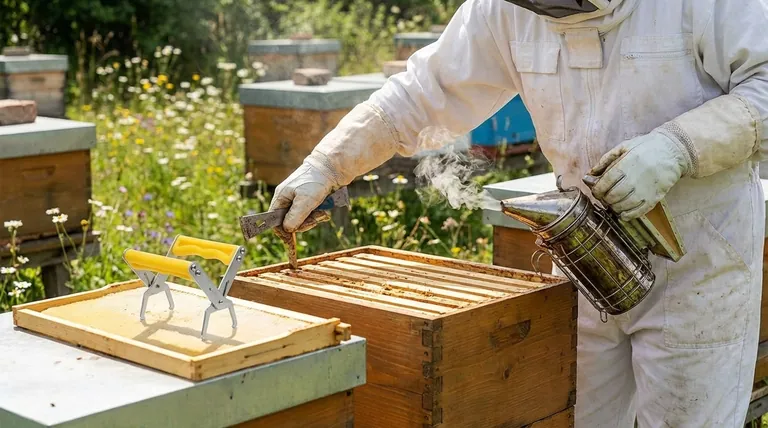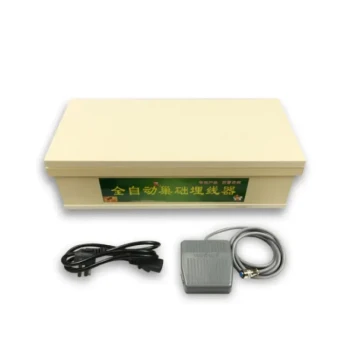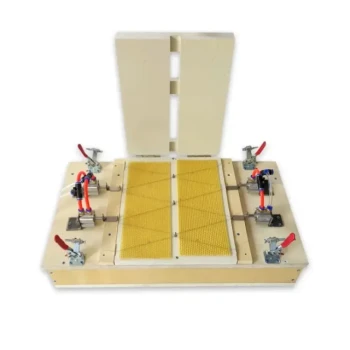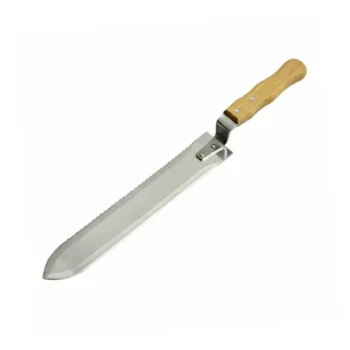To properly open a beehive, you must use a hive tool to gently pry apart the sealed components and apply light puffs of smoke to calm the colony. The process begins by removing the outer roof, carefully breaking the propolis seal on the inner cover with your tool, and puffing smoke across the top of the frames before proceeding with your inspection.
A successful hive opening is defined not by speed, but by a calm, deliberate procedure. The goal is to minimize colony stress and defensive behavior, allowing you to gather accurate information efficiently.

The Principles of a Calm Hive Opening
Understanding the "why" behind each step is critical for transitioning from a novice to a proficient beekeeper. Your actions should be guided by bee biology, not just mechanical process.
Why Smoke is Essential
Smoke is your primary tool for communication. A few gentle puffs trigger a feeding response in the bees; they begin to gorge on honey in case they need to abandon the hive.
This makes them physically fuller and more docile. Critically, the smoke also masks the alarm pheromone that guard bees release when they perceive a threat, preventing a chain reaction of defensiveness throughout the colony.
The Role of the Hive Tool
A hive is not just a box of loose parts. Bees seal every crack and seam with a sticky resin called propolis.
Your hive tool is a specialized lever designed to break these propolis seals with precision. Using it correctly allows you to separate hive bodies and frames with minimal jarring and without crushing bees.
The Importance of Deliberate Movement
Bees react to sudden movements, vibrations, and shadows. Approach the hive calmly and work with slow, deliberate motions.
Avoid standing directly in front of the hive entrance, which blocks the bees' flight path and can be interpreted as a threat.
A Step-by-Step Guide to Opening the Hive
Follow this sequence for a low-stress inspection. Have your smoker lit and your hive tool in hand before you begin.
Step 1: Approach and Initial Smoking
Approach the hive from the side or rear. Direct two or three gentle puffs of smoke into the main entrance.
Wait 30-60 seconds. This gives the smoke time to circulate and the bees time to begin responding.
Step 2: Removing the Outer and Inner Covers
Place the flat end of your hive tool between the main hive body and the outer cover (or roof) and gently pry it loose. Set it aside quietly.
Next, use your hive tool to carefully crack the propolis seal on the inner cover or hive mat. Pry it up slowly from a corner.
Step 3: Applying Smoke to the Top Bars
As you lift the inner cover, immediately direct a few light puffs of smoke across the top of the exposed frames.
This gentle application of smoke encourages the bees to move down and away from the top bars, giving you a clear space to begin your inspection.
Understanding the Trade-offs and Pitfalls
Even with a perfect procedure, beekeeping involves balancing competing needs. Being aware of common mistakes is crucial for colony health.
The Risk of Over-smoking
While essential, too much smoke can be counterproductive. It can disrupt colony function, taint honey, and in extreme cases, cause the bees to become agitated rather than calm. Use just enough to keep the colony manageable.
The Impact of Rough Handling
Moving too quickly or dropping equipment can crush bees and trigger a strong defensive response. Every crushed bee releases alarm pheromone, which can quickly override the calming effect of your smoke.
Inspection Frequency vs. Colony Stress
Every inspection is a major disruption. It breaks propolis seals the bees must repair and resets their workflow. While you need information, inspecting too often can stress the colony and slow its development.
For a newly installed package, wait several days to a week before the first inspection to allow the bees to settle.
How to Apply This to Your Inspection Goal
After successfully opening the hive, your next actions depend on your objective. Your goal dictates the depth and duration of your inspection.
- If your primary focus is a quick health check: Limit your work to the top box, looking for population density, food stores, and signs of new comb construction.
- If your primary focus is a full deep inspection: Work systematically from one side of the hive to the other, removing and examining each frame for brood pattern, the presence of eggs, and signs of disease.
- If your primary focus is swarm prevention: Concentrate on finding and managing queen cells and ensuring the colony has adequate space to expand.
Ultimately, mastering the hive opening is the foundation for becoming a confident and effective beekeeper.
Summary Table:
| Step | Key Action | Purpose |
|---|---|---|
| 1. Approach & Smoke | Puff smoke into the entrance | Calms bees, triggers feeding response, masks alarm pheromones |
| 2. Remove Covers | Use hive tool to break propolis seal | Separates components without jarring or crushing bees |
| 3. Smoke Top Bars | Apply light puffs across frames | Encourages bees to move down, creating a clear workspace |
| Pitfall to Avoid | Consequence | Best Practice |
| Over-smoking | Agitated bees, disrupted colony function | Use gentle, minimal puffs |
| Rough handling | Crushed bees release alarm pheromones | Use slow, deliberate movements |
Ready to conduct inspections with confidence? A successful beekeeping operation depends on reliable, high-quality equipment. HONESTBEE supplies commercial apiaries and beekeeping equipment distributors with the durable, professional-grade tools needed for low-stress hive management. From essential hive tools to efficient smokers, our wholesale-focused operations ensure you have what you need for a thriving apiary.
Contact HONESTBEE today to discuss your equipment needs and wholesale pricing.
Visual Guide

Related Products
- Ergonomic High Visibility Plastic Frame Grip Handles
- Ergonomic Two Person Foldable Hive Lifter
- HONESTBEE Wooden Bar Copper Prong Wire Embedder for Battery Operation
- Professional Pneumatic Wire Embedder for Beehive Frames
- Manual Spur Wheel Wire Embedder for Foundation
People Also Ask
- How should a hive tool be used for hive inspection? Master the Essential Beekeeper's Multi-Tool
- How is the standard hive tool used in beekeeping? Master Essential Hive Management
- What is a beekeeper tool? The Essential Hive Management Lever for Apiaries
- What is the recommended method for pushing multiple frames back into place? Master the 2-4 Frame Technique for Bee Safety
- Should I buy a regular or J-hook hive tool? Choose the Right Tool for Your Beekeeping Needs



















